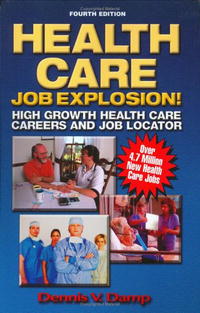Health Care Job Explosion offers a distinct advantage over other books of this type. It is two books in one — a comprehensive CAREER GUIDE plus a dynamic JOB FINDER. First, it provides a detailed description of each of the major health care career fields. Second, comprehensive resources are listed for job announcements (publications with job ads, job hotlines, Internet sites for job seekers, and job fairs), placement services, directories, and general information (associations, career-oriented web sites, and job related books). This dual format permits comparisons between specialties and offers insight into qualifications, cross-training potential, and pay. The job descriptions list occupations with similar skill and training requirements.
Later chapters explore the following occupation groups: Health Technologists
Health Technicians
Dietetics, Pharmacy, and Therapy
Nursing
Health and Social Services
Health Diagnosing and Assistants
Home Health Care and Computers
The job descriptions offer the most up-to-date information available from the Bureau of Labor Statistics" 2006-2007 Occupational Outlook Handbook, interspersed with succinct input provided from many health care professionals and organizations. Each occupational listing covers the nature of the work, working conditions, employment statistics, training, other qualifications, advancement, job outlook, earnings, and related occupations. Following each job description is a carefully selected list of invaluable career and job resources. The all new fourth edition covers all major occupational groups and includes a comprehensive chapter on home health care, over 1400 updated resources, expanded sections, and interviews with health care workers. Our web site at healthcarejobs.org was created exclusively for this title.
VARIETY AND GROWTH CHARACTERIZE THE FIELD
The opportunities aren"t limited to traditional health care occupations. Health care institutions will need thousands of additional accountants, auditors, personnel specialists, directors of personnel, attorneys, buyers, computer programmers, researchers, computer support specialists, chemists, engineers, drafters, computer operators, Photographers, file clerks, secretaries, purchasing clerks, and food service helpers. Furthermore, employment growth is not limited to the traditional full-time job. Part time employment is on the increase as well.
The increased demand for health care services, fed by the growing proportion of elderly in the population, is expected to continue for a full 50 years! According to the Administration on Aging the number of Americans over age 65 is expected to grow to 40.2 million by 2010 and to 71.5 million by 2030. Older Americans spend more than twice that of all others on medical services. The health care needs of this population will contribute greatly to the creation of new jobs.
Thirteen of the 20 occupations with the fastest projected growth rate are in health care. (See Table 1-1 in the book.) The Bureau of Labor Statistics (BLS) predicts that the private hospital industry is expected to employ nearly 5 million people by 2014, which will make it the seventh largest source of employment growth. Employment in doctor"s offices and clinics will also increase and the BLS expects a 56% increase in home health aides. Health care manpower shortages are now commonplace and many health care providers take months to locate qualified personnel. An American Hospital Association survey found that the health care workforce is shrinking while demand for hospital care rose in 2004.
It is not just traditional medical jobs that are growing. According to the Bureau of Labor Statistics, of the seven remaining 20 fastest-growing occupations, five are in computers (an industry with increasing importance in medicine) while two are medical related: medical scientists and forensic science technicians. Это и многое другое вы найдете в книге Health Care Job Explosion: High Growth Health Care Careers and Job Locator (Dennis V. Damp)















